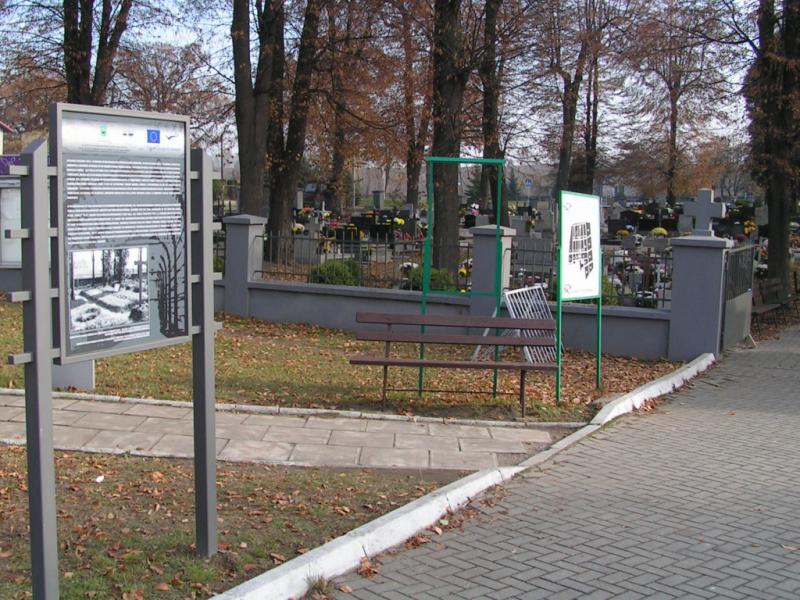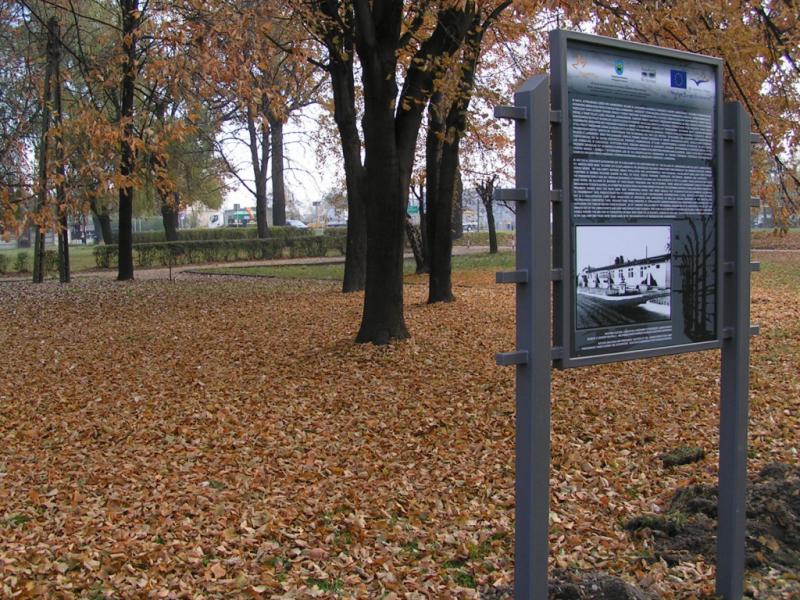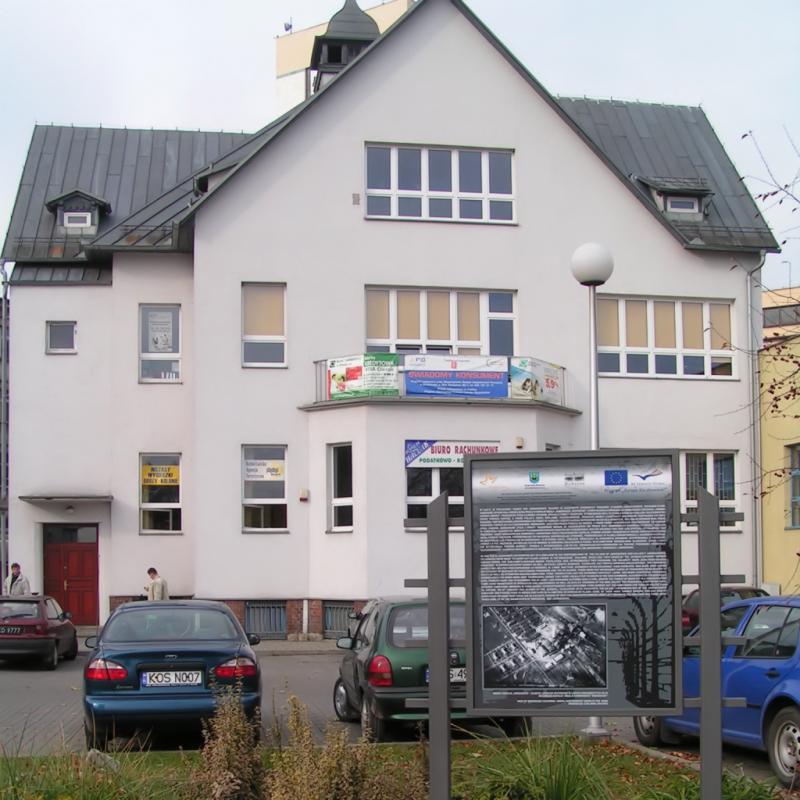Memorials and plaque
-
Communal cemetery in Brzeszcze
In the second half of 1944, on account of an imminent Red Army offensive, the SS authorities began a gradual evacuation of prisoners from KL Auschwitz and deported them into the Third Reich’s interior.
An order for the total evacuation of the camp was issued in 1945. From 17th to 21st January SS guards led approximately 56,000 male and female prisoners from KL Auschwitz and its sub-camps and forced them to march down various roads to Gliwice and Wodzisław Śląski some 60 km away. From there they were transported by train to concentration camps in the German interior.
Around 25 thousand male and female prisoners passed through the main street of Brzeszcze. Some of them were unable to endure the hardships of this march and died either of exhaustion or were shot by escorting SS guards.
On 19th January, when last prisoner evacuation column had passed, the German mayor of Brzeszcze ordered the inhabitants to bury the bodies. They collected 18 corpses on the stretch of road from Rajsko to Jawiszowice and buried them in a common grave in the local cemetery.Wirtschaftshof Budy (Budy Farm)
In 1941 the KL Auschwitz authorities, having evicted the local inhabitants and confiscated their landed property, set up the so-called Wirtschaftshof Budy (Budy farm) in an area covering Budy, Bór and part of NazieleĹ„ce.
Within this zone they founded a male prisoners’ sub-camp that functioned from 1941 to 1945, a female penal company (1942-1943) and a women’s sub-camp (1943-1944). The male and female Jewish, Polish, French, Gypsy, Ukrainian, Russian and Czech prisoners were made to carry out slave labour for the Third Reich.
The male prisoners were employed in arable farming and stock rearing, the women of the penal company demolished local buildings, built roads and an anti-flooding wall on the Vistula and also cleared ponds, whereas the women’s sub-camp inmates worked in the fields and forests, in tree nurseries, draining fields and cutting wicker.
All the prisoners were made to work for more than twelve hours a day, usually regardless of weather conditions. The fate of the women of the penal company was particularly tragic. They were not only forced to work for many hours beyond their physical abilities, frequently in the cold water of the fish ponds they had to clear, but they were also beaten by the SS-men and prisoner functionaries, all of which contributed to their high death rate. At the start of October 1942 the German female prisoner functionaries and SS guards massacred some 90 female penal company prisoners, mainly French Jewish women.
Despite the threat of being themselves put in a concentration camp, some Brzeszcze inhabitants helped the male and female prisoners, providing them with food, mediating in secret correspondence and assisting in prisoner escapes.Jawischowitz sub-camp
In 1942 the KL Auschwitz authorities set up a sub-camp in the northern part of the village of Jawiszowice and called it Jawischowitz. Its inmates were made to carry out slave labour in the Brzeszcze coalmine, which was then owned by the German concern, Herman Göring Werke. The sub-camp’s average inmate population was approximately two thousand. The majority were Jews from various countries in German occupied Europe as well as Poles, Czechs, Russians, Yugoslavs, the French, Germans and Austrians.
The prisoners rarely had any previous experience of working in a mine and thus accidents often occurred. Their condition was made even worse on account of beatings by functionary prisoners and the SS guards. There were not infrequent cases of prisoners being beaten to death as well as attempted suicides resulting from persecution and the extremely difficult living and work conditions. Prisoners deemed unfit for work were sent to Birkenau, where they were usually put to death in the gas chambers. According to fragmentary data, from October 1942 to December 1944 at least 1,800 prisoners suffered such a fate.
Despite the threat of being put in a concentration camp, some inhabitants of Brzeszcze and Jawiszowice as well as civilian workers at the mine helped the prisoners, comforted them, brought them food, mediated in their secret correspondence and sometimes even carried out the hard work for them or helped them to escape.
On 19th January 1945, as part of the general evacuation of KL Auschwitz, the SS led 1,900 inmates out of the Jawischowitz sub-camp and forced them to march for over 50 kilometres to Wodzisław Śląski. Some of them were unable endure this and died of exhaustion or were shot dead the SS escorts. Dozens of sick and exhausted inmates were left behind in the sub-camp and these were taken care of by the inhabitants of Brzeszcze and Jawiszowice.Brzeszcze coalmine
During the German occupation the Brzeszcze coalmine was taken over by the state concern Herman Göring Werke. In order to increase the rate of extracting coal, in 1942 the German management of the mine employed KL Auschwitz prisoners, for whom the Jawischowitz sub-camp was built. This was the first instance in the history of German concentration camps of prisoners being put to work underground.
The average inmate population was approximately two thousand. The majority were Jews from various German occupied countries as well as Poles, Czechs, Russians, Yugoslavs, Frenchmen, Germans and Austrians.
Despite the threat of being put in a concentration camp, some coalmine employees helped the prisoners. They comforted them, gave them food, mediated in their secret correspondence, sometimes did their work for them or even assisted in their escapes. This project has been funded with support from the European Commission.
This project has been funded with support from the European Commission.
This publication [communication] reflects the views only of the author, and the Commission cannot be held responsible for any use which may be made of the information contained therein.OK




